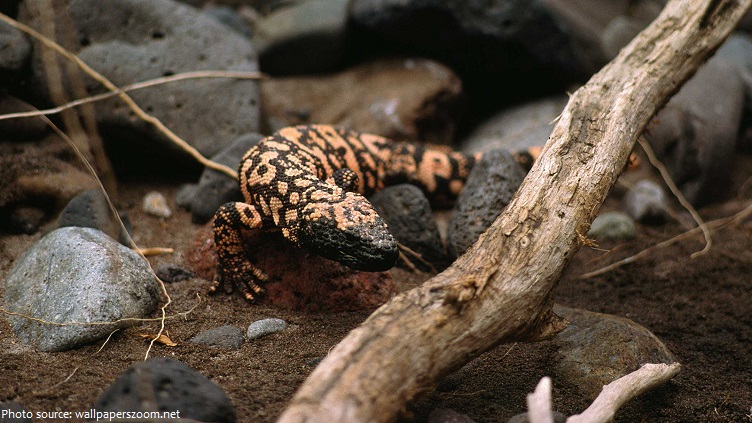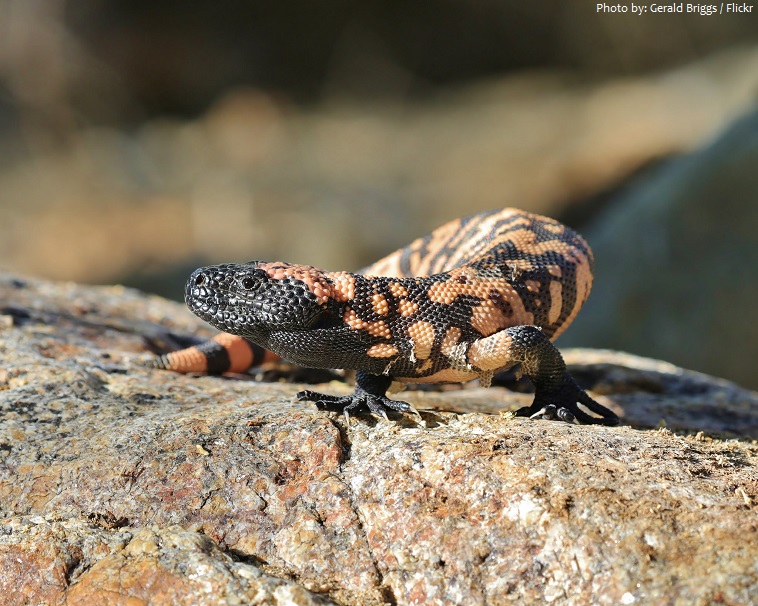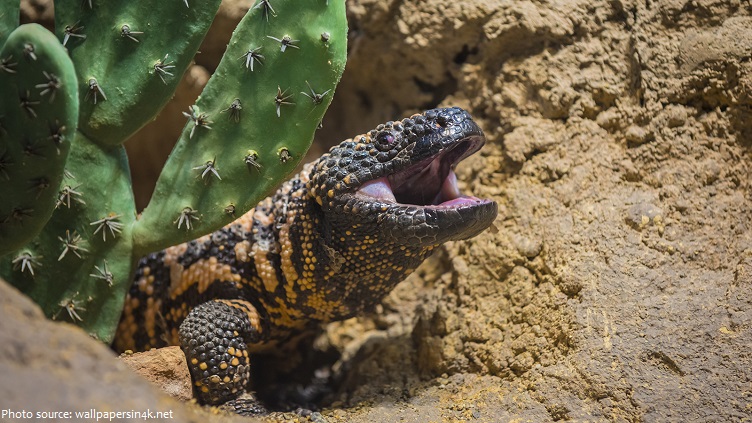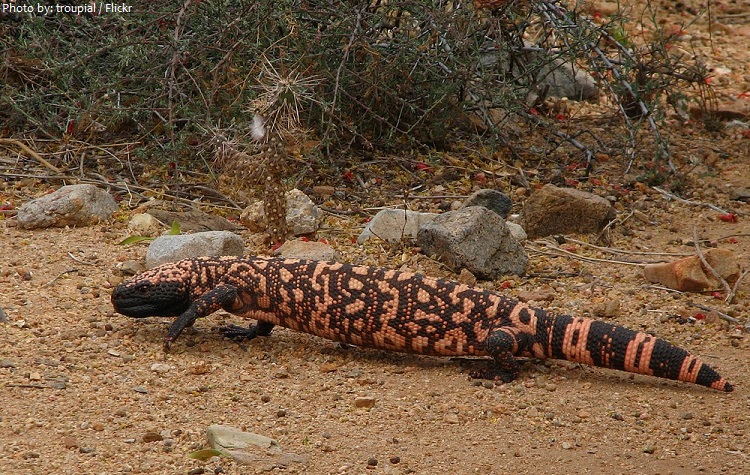The Gila monster (Heloderma suspectum) is a species of venomous lizard.
It is found in the Southwestern United States and Mexico, a range including Sonora, Arizona, parts of California, Nevada, Utah, and New Mexico.
The Gila monster ranges from sea level to 1,500 meters (4,920 feet) in altitude.
They inhabit scrubland, succulent desert, and oak woodland, seeking shelter in burrows, thickets, and under rocks in locations with ready access to moisture. In fact, Gila monsters seem to like water and can be observed immersing themselves in puddles of water after a summer rain.
The Gila monster and its close cousin, the Mexican beaded lizard (Heloderma horridum), are the only two venomous lizards in the world.
The lifespan of the Gila monster is up to 20 years in the wild and up to 30 years in captivity.
The Gila monster is the largest lizard in the United States; large adults measure up to 51-56 cm (20-22 in) in length, with the tail making up only 20% of its entire length; a weight averaging between 350-700 g (0.77-1.54 lb).
Gila monsters are black, patterned along their backs with contrasting pink or orange. The bright colorsof these scales are thought to warn predators to stay away.
The black eyes have a round pupil. The ear opening is a narrow oblique or ovoid slit. The limbs of the lizard are stout and have heavy claws.
Its venom is made by a row of glands in the lizard’s lower jaw. When the lizard bites, small grooves in the teeth help the venom flow into its prey. The bite of a Gila monster is very strong, and the lizard may not loosen its grip for several seconds. It may even chew so that the venom goes deeper into the wound.
The monster’s venom may be more useful as a defense against predators rather than for hunting, because most of the lizard’s prey is small enough to be subdued by the strength of the bite.
Gila monster venom is about as toxic as that of a western diamondback rattlesnake. However, a relatively small amount of venom is introduced in a Gila bite.
Currently, there is no antivenom for Gila monster bites. A Gila monster bite is painful to humans, butit rarely causes death. The biggest problem you might have if a Gila monster bit you is trying to get the lizard to release its grip! A strong stick to pry apart the jaws is recommended.
The Gila monster uses its extremely acute sense of smell to locate prey, especially eggs. Its sense of smell is so keen, it can locate and dig up chicken eggs buried 15 cm (6 in) deep and accurately follow a trail made by rolling an egg. The Gila monster, like most snakes, uses its tongue for smelling.
The Gila monster eats small birds, mammals, frogs, lizards, insects, carrion and eggs. The Gila monster feeds primarily on bird and reptile eggs, and eats infrequently (only 5 to 10 times a year in the wild). Gila monsters are able to climb trees and cacti in search of eggs.
The Gila monster can eat a third of its body weight in one meal.
Prey may be crushed to death if large or eaten alive if small, swallowed head-first, and helped down by muscular contractions and neck flexing.
They spend about 95 percent of their time underground and emerge only to hunt for food or to take a sunbath.
During cold winter months, Gila monsters stay in burrows dug with their stout claws or even burrows of desert tortoises and have fat stores in their tail to keep them alive during this time.
Gila monsters walk high on their short legs, with the tail clear of the ground and swinging from sideto side for balance, in what looks like an awkward gait. Their top speed is only 2.4 kilometers per hour (1.5 miles per hour).
Good climbers, Gila monsters are sometimes found fairly high up in cholla cactus and trees foraging for bird eggs in nests.
Gila monsters seem to have a loose social structure and occasionally share shelters. Males compete for mates by engaging in carefully choreographed wrestling matches, in which the biggest and strongest animal wins.
Breeding season for Gila monsters is usually in May and June. The female lays eggs in July or August, burying them in sand 13 cm (5 in) below the surface. The clutch consists of two to 12 eggs: five is the average. The incubation lasts nine months, as the hatchlings emerge during April through June the following year. They are about 16 cm (6.3 in) long, and look like miniature adults with more vivid coloring. The hatchlings are ready to begin life on their own, no training required!
Although these tough “monsters” are often thought of as being practically predator-free, an assortment of animals are suspected of sometimes hunting them. These animals include foxes, mountain lions, coyotes and birds of prey.
Though the Gila monster is venomous, its laggard movement means it poses little threat to humans. However, it has earned a fearsome reputation and is often killed by humans because of fear.
Among Native American tribes, the Gila monster had a mixed standing. The Apache believed its breath could kill a man, and the Tohono O’Odham and the Pima believed it possessed a spiritual power that could cause sickness. In contrast, the Seri and the Yaqui believed the Gila monster’s hide had healing properties.
In 1952, Gila monsters became the first venomous animal to be given legal protection.
Today, Gila monsters are listed as Near Threatened by the International Union for Conservation of Nature (IUCN).
The Gila monster is named for the Gila River in Arizona.
A drug for the management of Type 2 diabetes is based on a protein from the Gila monster’s saliva. The drug is sometimes referred to as lizard spit.





